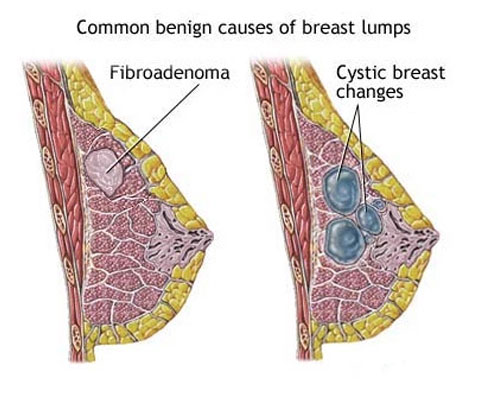Benign Breast Disease

Don't panic. Nearly eighty percent of all breast lumps are benign (non-cancerous). Benign breast lumps are usually moveable and smooth, and can often be found in both breasts. There are several common causes of benign breast lumps:
- Benign breast changes
- Breast infection or injury
- Medications that may cause lumps or breast pain, especially birth control pills, hormone replacement therapy, soy products, and caffeine.
Breast tissue changes during a woman's entire life. Breast tissue is particularly sensitive to estrogen and progesterone hormone levels that often fluctuate during the menstrual cycle.
What are the types of benign breast conditions?
- Fibrocystic changes - Changes in hormone balances during normal, monthly menstrual cycles can create, for some women, symptomatic breast changes that are referred to as fibrocystic changes. Cysts often are described as benign, tiny, fluid-filled sacs that may feel like lumps. Tenderness and lump size commonly increase the week before the menstrual period and lessen a week after. The lumps may be hard or rubbery and can appear as a single breast lump that may be large or small. Fibrocystic changes also can appear as thickening of the breast tissue. Fibrocystic changes can occur in one or both breasts and are the most common cause of benign breast lumps in women age 35 to 50. It is relatively uncommon for postmenopausal women to have symptomatic breast changes because of a lack of hormone stimulation of breast tissue.
- Simple cysts - Simple cysts are benign fluid-filled sacs that usually occur in both breasts. They can be single or multiple and can vary in size. Tenderness and lump size often change with the woman's menstrual cycle. Cysts may also be affected by caffeine (coffee, tea, chocolate, energy drinks).
- Fibroadenomas - Fibroadenomas are the most common benign solid tumors found in the female breast. They are round, rubbery, slippery lumps that move freely in the breast when pushed. They form as the result of excess formation of lobules (milk-producing glands) and stroma (connective tissue in the breast). Fibroadenomas are usually painless. They occur most often between the ages of 20 and 40 and are more common in African-American women.
- Intraductal papillomas - These are small, wart-like growths in the lining of the mammary duct near the nipple. They usually affect women 40 to 50 years of age and can produce bleeding from the nipple or nipple discharge.
- Traumatic fat necrosis - This condition occurs when there is trauma (sudden injury) or surgery to the breast. This causes fat to form in lumps. The lumps are usually round, firm, hard, single, painless and in the area of a surgical scar.
